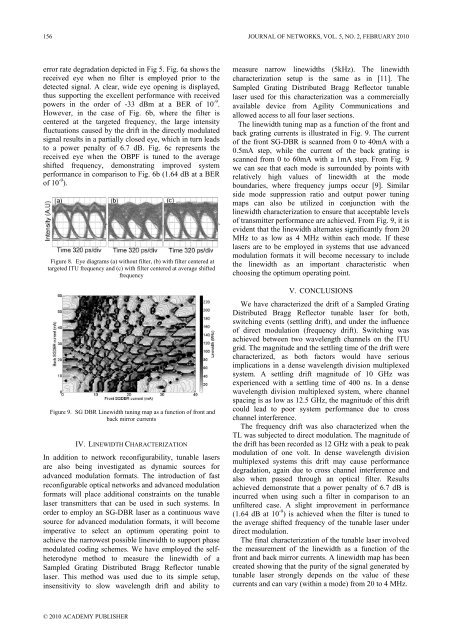Journal of Networks - Academy Publisher
Journal of Networks - Academy Publisher
Journal of Networks - Academy Publisher
You also want an ePaper? Increase the reach of your titles
YUMPU automatically turns print PDFs into web optimized ePapers that Google loves.
156 JOURNAL OF NETWORKS, VOL. 5, NO. 2, FEBRUARY 2010<br />
error rate degradation depicted in Fig 5. Fig. 6a shows the<br />
received eye when no filter is employed prior to the<br />
detected signal. A clear, wide eye opening is displayed,<br />
thus supporting the excellent performance with received<br />
powers in the order <strong>of</strong> -33 dBm at a BER <strong>of</strong> 10 -9 .<br />
However, in the case <strong>of</strong> Fig. 6b, where the filter is<br />
centered at the targeted frequency, the large intensity<br />
fluctuations caused by the drift in the directly modulated<br />
signal results in a partially closed eye, which in turn leads<br />
to a power penalty <strong>of</strong> 6.7 dB. Fig. 6c represents the<br />
received eye when the OBPF is tuned to the average<br />
shifted frequency, demonstrating improved system<br />
performance in comparison to Fig. 6b (1.64 dB at a BER<br />
<strong>of</strong> 10 -9 ).<br />
Figure 8. Eye diagrams (a) without filter, (b) with filter centered at<br />
targeted ITU frequency and (c) with filter centered at average shifted<br />
frequency<br />
Figure 9. SG DBR Linewidth tuning map as a function <strong>of</strong> front and<br />
back mirror currents<br />
IV. LINEWIDTH CHARACTERIZATION<br />
In addition to network reconfigurability, tunable lasers<br />
are also being investigated as dynamic sources for<br />
advanced modulation formats. The introduction <strong>of</strong> fast<br />
reconfigurable optical networks and advanced modulation<br />
formats will place additional constraints on the tunable<br />
laser transmitters that can be used in such systems. In<br />
order to employ an SG-DBR laser as a continuous wave<br />
source for advanced modulation formats, it will become<br />
imperative to select an optimum operating point to<br />
achieve the narrowest possible linewidth to support phase<br />
modulated coding schemes. We have employed the selfheterodyne<br />
method to measure the linewidth <strong>of</strong> a<br />
Sampled Grating Distributed Bragg Reflector tunable<br />
laser. This method was used due to its simple setup,<br />
insensitivity to slow wavelength drift and ability to<br />
© 2010 ACADEMY PUBLISHER<br />
measure narrow linewidths (5kHz). The linewidth<br />
characterization setup is the same as in [11]. The<br />
Sampled Grating Distributed Bragg Reflector tunable<br />
laser used for this characterization was a commercially<br />
available device from Agility Communications and<br />
allowed access to all four laser sections.<br />
The linewidth tuning map as a function <strong>of</strong> the front and<br />
back grating currents is illustrated in Fig. 9. The current<br />
<strong>of</strong> the front SG-DBR is scanned from 0 to 40mA with a<br />
0.5mA step, while the current <strong>of</strong> the back grating is<br />
scanned from 0 to 60mA with a 1mA step. From Fig. 9<br />
we can see that each mode is surrounded by points with<br />
relatively high values <strong>of</strong> linewidth at the mode<br />
boundaries, where frequency jumps occur [9]. Similar<br />
side mode suppression ratio and output power tuning<br />
maps can also be utilized in conjunction with the<br />
linewidth characterization to ensure that acceptable levels<br />
<strong>of</strong> transmitter performance are achieved. From Fig. 9, it is<br />
evident that the linewidth alternates significantly from 20<br />
MHz to as low as 4 MHz within each mode. If these<br />
lasers are to be employed in systems that use advanced<br />
modulation formats it will become necessary to include<br />
the linewidth as an important characteristic when<br />
choosing the optimum operating point.<br />
V. CONCLUSIONS<br />
We have characterized the drift <strong>of</strong> a Sampled Grating<br />
Distributed Bragg Reflector tunable laser for both,<br />
switching events (settling drift), and under the influence<br />
<strong>of</strong> direct modulation (frequency drift). Switching was<br />
achieved between two wavelength channels on the ITU<br />
grid. The magnitude and the settling time <strong>of</strong> the drift were<br />
characterized, as both factors would have serious<br />
implications in a dense wavelength division multiplexed<br />
system. A settling drift magnitude <strong>of</strong> 10 GHz was<br />
experienced with a settling time <strong>of</strong> 400 ns. In a dense<br />
wavelength division multiplexed system, where channel<br />
spacing is as low as 12.5 GHz, the magnitude <strong>of</strong> this drift<br />
could lead to poor system performance due to cross<br />
channel interference.<br />
The frequency drift was also characterized when the<br />
TL was subjected to direct modulation. The magnitude <strong>of</strong><br />
the drift has been recorded as 12 GHz with a peak to peak<br />
modulation <strong>of</strong> one volt. In dense wavelength division<br />
multiplexed systems this drift may cause performance<br />
degradation, again due to cross channel interference and<br />
also when passed through an optical filter. Results<br />
achieved demonstrate that a power penalty <strong>of</strong> 6.7 dB is<br />
incurred when using such a filter in comparison to an<br />
unfiltered case. A slight improvement in performance<br />
(1.64 dB at 10 -9 ) is achieved when the filter is tuned to<br />
the average shifted frequency <strong>of</strong> the tunable laser under<br />
direct modulation.<br />
The final characterization <strong>of</strong> the tunable laser involved<br />
the measurement <strong>of</strong> the linewidth as a function <strong>of</strong> the<br />
front and back mirror currents. A linewidth map has been<br />
created showing that the purity <strong>of</strong> the signal generated by<br />
tunable laser strongly depends on the value <strong>of</strong> these<br />
currents and can vary (within a mode) from 20 to 4 MHz.

















